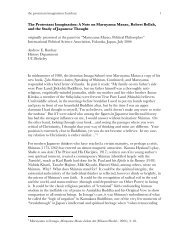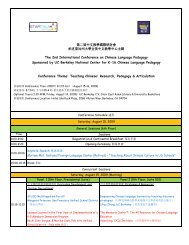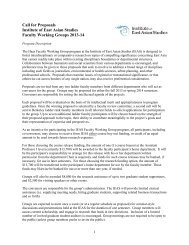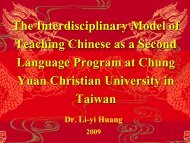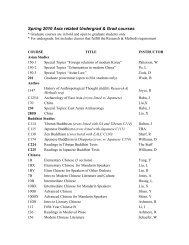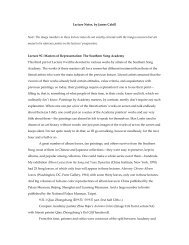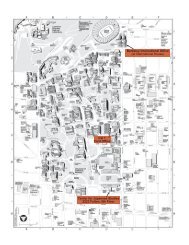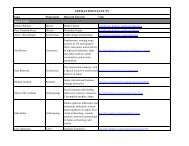Third Edition Spring 2013 - Institute of East Asian Studies, UC ...
Third Edition Spring 2013 - Institute of East Asian Studies, UC ...
Third Edition Spring 2013 - Institute of East Asian Studies, UC ...
Create successful ePaper yourself
Turn your PDF publications into a flip-book with our unique Google optimized e-Paper software.
the clients (yajamāna, Newari: jajmān) these priests serve are likewisehereditary. Nevertheless, the role <strong>of</strong> the priest is extremelyimportant, as the priests perform the day-to-day rituals <strong>of</strong> NewarBuddhist religious life, including life-cycle rituals, funerary rites,and the very important fire ritual (homa). 12 It is important to keepin mind that the actual priests who perform rituals for their clientsare, just as the householder monks, married individuals who gaveup their monastic vows as children. This means that, from a differentBuddhist perspective, householder priests are living contradictions;on the one hand, they are fully capable <strong>of</strong> acting as monkpriests,but on the other they have ceased being monks <strong>of</strong>ficially.Yet the Newar lay community does not appear to consider themincapable <strong>of</strong> performing their duties as priests and does not considerthem unusual.Despite having given up their vows, the relationship thesemonks have with their parishioners as figures with religious poweris just as real as in the Theravada tradition. However, NewarBuddhism’s relationship with the state stands in stark contrast tothe Buddhism <strong>of</strong> Sri Lanka and Thailand. Nepal has, to put it mildly,suffered a series <strong>of</strong> challenges since the 1950s and is just nowbeginning to take steps toward stability, along with the recent introduction<strong>of</strong> Internet technology and other conveniences. It is notsurprising that in this context, Newar Buddhism has struggled t<strong>of</strong>ind its place. The modern state has done little to protect NewarBuddhism from challenges to its religious existence; “Most <strong>of</strong> theland endowed for religious purposes over the centuries has comeunder governmental control or been misappropriated, therebyeffectively depriving Newar Buddhism <strong>of</strong> the material basis thattraditionally secured the continuation <strong>of</strong> its cultures and practicesand upkeep <strong>of</strong> its monasteries.” 13 While it would perhaps beoverstating things to view this as a direct state-sponsored threatto Newar Buddhism, it is certainly indicative <strong>of</strong> a larger trend. Inshort, rather than having a strong state/sangha relationship asin Sri Lanka or Thailand (where the modern state and the sanghacontinue to have a tight relationship that extends into the political)12 Von Rospatt p. 29313 Von Rospatt p. 296the Newar tradition does not maintain such a close relationship.While it is certainly true that the former king <strong>of</strong> Nepal engaged inthe ritual celebrations <strong>of</strong> the Buddhist community and it was possibleto see a kind <strong>of</strong> jostling for position between the king and thesangha during these rituals, the king was not granted any “moralauthority” from the Newar sangha to govern the country. The Nepaleseking’s duty was to protect all the religions <strong>of</strong> the KathmanduValley, rather than just Buddhism. In this context, it is importantto note that the king himself was not Buddhist, but rather Hindu.Thus, unlike the Theravada traditions from which the identity <strong>of</strong>the state and the religious identity <strong>of</strong> Buddhism are almost inseparable,there does not appear to be such a deep connection betweenthe former Hindu monarchy <strong>of</strong> Nepal and Newar Buddhism. NewarBuddhism’s defining qualities do not include a rooted relationshipto the state.Japanese Buddhism in the Late Edo and Meiji PeriodsThe story <strong>of</strong> Japanese Buddhism’s evolution into its currentform cannot be understood without first exploring its form in theEdo period.Buddhism arrived in Japan in the 6th century and spreadfrom a practice <strong>of</strong> elites in the court to the entire country. Buddhistsanghas grew in power, and were even considered threats by secularleaders interested in power. Oda Nobunaga’s rivalry with thewarrior monks <strong>of</strong> the Tendai sect, resulting in his famous destruction<strong>of</strong> their Mt. Hiei temples and the killing <strong>of</strong> almost 3,000 peoplein 1571, is probably the best-known example <strong>of</strong> this type <strong>of</strong> antagonism.14 However, with the defeat <strong>of</strong> Tokugawa’s enemies and thebeginning <strong>of</strong> the Edo period’s political stability, Buddhism enteredinto a long and productive partnership with the Japanese state.The first part <strong>of</strong> this partnership was based on the Tokugawagovernment’s attempts to take a census <strong>of</strong> the nation’s populationand its efforts to control population movement. In order to accomplishthese goals, the Tokugawa government enlisted the help14 Bowring 200593 Robert Bowers Curl Laicization in Japanese Buddhism 94




